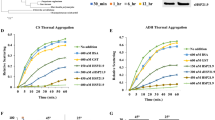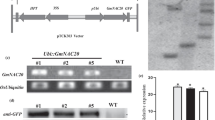Abstract
The SAMS (S-adenosylmethionine synthetase) gene is known to play an important role in the mechanism of cold resistance, as overexpression of this gene results in phenotypic changes in T1-generation transgenic plants. Accordingly, this study was conducted to test the expression of the MsSAMS gene in T2-generation transgenic plants and to investigate the resistance of these plants and the function of the transgene in response to various environmental stresses. For the morphological analysis of T2-generation transgenic plants overexpressing the MsSAMS gene, observations using scanning electron microscopy (SEM) were performed. T2-generation transgenic plants were obtained by planting a total of 5 lines, and their characteristics were tested by comparisons with those of the control. SEM revealed that the thickest leaves were produced by the T6 transgenic line—161.24 ± 8.05 µm. The number of stomata ranged from 20.00 ± 2.65 to 34.00 ± 1.00 in the T2-generation transgenic plants, but the control had more stomata. Resistance to various factors, such as low temperature, drought, and oxidative stress, in the T2-generation transgenic plants was also confirmed. Under cold-stress conditions, the T6 transgenic line presented the lowest value (22.73%) of ion leakage, and under drought-stress conditions, compared with the control, the transgenic lines presented lower ion leakage after being treated with various concentrations of mannitol. Even under oxidative-stress conditions, the T2-generation transgenic plants presented ion leakage levels that were 32.91 ± 4.24 to 48.33 ± 3.54% lower than those of the control after treatment with various concentrations of methyl viologen. Regarding SAMS enzyme activity, as the duration of cold treatment increased, the activity in the transgenic plants tended to decrease and then increase. During 48 h of cold treatment, the control showed a decrease in SAM content, while the T2-generation transgenic plants presented an increase in SAM content, from 13.58 ± 1.04 to 22.75 ± 1.95 mg protein/g FW. The results suggest that the MsSAMS gene may be important to the mechanisms of resistance to oxidative and drought stresses in addition to its previously known association with cold resistance. Based on these results, it was suggested that the MsSAMS gene, whose expression is induced by cold stress, can serve as a marker of various responses to environmental stresses, because resistance to cold damage and various environmental stresses are stably inherited in the T2 generation.



Similar content being viewed by others
References
Altieri MA, Nicholls CI (2017) The adaptation and mitigation potential of traditional agriculture in a changing climate. Clim Chang 140:33–45
Bradford MM (1976) A rapid and sensitive method for the quantitation of microgram quantities of protein utilizing the principle of protein-dye binding. Anal Biochem 72:248–254
Choi IY, Han SG, Kang CH, Song YJ, Lee WH (2008) The characterization of transgenic chrysanthemum under low temperature condition. J Plant Biotechnol 35:55–61
Dasgupta R, Garcia BH, Goodman RM (2001) Systemic spread of an RNA insect virus in plants expressing plant viral movement protein genes. Proceed Nat Acad Sci USA 98:4910–4915
Ding B, Chen T, Yang Y, Liu S, Yan K, Yue X, Zhang H, Xiang Y, An L, Chen S (2015) Molecular cloning and characterization of an S-adenosylmethionine synthetase gene from Chorispora bungeana. Gene 572:205–213
Fita A, Rodríguez-Burruezo A, Prohens J, Vicente O (2015) Breeding and domesticating crops adapted to drought and salinity: a new paradigm for increasing food production. Front Plant Sci 6:978
Finkelstein JD (1990) Methionine metabolism in mammals. J Nut Biochem 1:228–237
Goodin MM, Zaitlin D, Naidu RA, Lommel SA (2008) Nicotiana benthamiana: its history and future as a model for plant–pathogen interactions. Mol Plant-Microbe Inter 21:1015–1026
Guo Z, Tan J, Zhuo C, Wang C, Xiang B, Wang Z (2014) Abscisic acid, H2O2 and nitric oxide interactions mediated cold-induced S-adenosylmethionine synthetase in Medicago sativa subsp. falcata that confers cold tolerance through up-regulating polyamine oxidation. Plant Biotech 12:601–612
Hann DR, Rathjen JP (2007) Early events in the pathogenicity of Pseudomonas syringae on Nicotiana benthamiana. Plant J 49:607–618
Harpaz-Saad S, Yoon GM, Mattoo AK, Kieber JJ (2012) The formation of ACC and competition between polyamines and ethylene for SAM. Annu Plant Rev 44:53–81
He M, Wang Y, Wu J, Shu S, Sun J, Guo S (2019) Isolation and characterization of S-adenosylmethionine synthase gene from cucumber and responsive to abiotic stress. Plant Physiol Biochem 141:431–445
Hetherington AM, Woodward FI (2003) The role of stomata in sensing and driving environmental change. Nature 424:901–908
Jia XL, Wang GL, Xiong F, Yu XR, Xu ZS, Wang F, Xiong AS (2015) De novo assembly, transcriptome characterization, lignin accumulation, and anatomic characteristics: novel insights into lignin biosynthesis during celery leaf development. Sci Rep 5:8259
Kim SH, Kim SH, Palaniyandi SA, Yang SH, Suh J (2015) Expression of potato S-adenosyl-L-methionine synthase (SbSAMS) gene altered developmental characteristics and stress responses in transgenic Arabidopsis plants. Plant Physiol Biochem 87:84–91
Lee JH, Chae HS, Lee JH, Hwang B, Hahn KW, Kang BG, Kim WT (1997) Structure and expression of two cDNAs encoding S-adenosyl-L- methionine synthetase of rice (Oryza sativa L.). Biochim Biophysic Acta(BBA)-Gene Struc Express 1354:13–18
Li W, Han Y, Tao F, Chong K (2011) Knockdown of SAMS genes encoding S-adenosyl-l-methionine synthetases causes methylation alterations of DNAs and histones and leads to late flowering in rice. J Plant Physiol 168:1837–1843
Machado Neto NB, Saturnino SM, Bomfim DC, Custódio CC (2004) Water stress induced by mannitol and sodium chloride in soybean cultivars. Brazil Arch Biol Technol 47:521–529
Pang C, Wang C, Chen H, Guo Z, Li C (2009) Transcript profiling of cold responsive genes in Medicago falcata. In: Yamada T, Spangenberg G (eds) Molecular Breeding of Forage and Turf. Springer, Netherlands, pp 141–149
Park HJ, Lee A, Lee SS, An D, Moon K, Ahn JC, Kim H, Cho HS (2017) Overexpression of golgi protein CYP21-4s improves crop productivity in potato and rice by increasing the abundance of mannosidic glycoproteins. Front Plant Sci 8:1250
Peleman J, Saito K, Cottyn B, Engler G, Seurinck J, Van Montagu M, Inzé D (1989) Structure and expression analyses of the S-adenosylmethionine synthetase gene family in Arabidopsis thaliana. Gene 84:359–369
Pulla RK, Kim Y, Parvin S, Shim J, Lee J, Kim Y, In J, Senthil KS, Yang D (2009) Isolation of S-adenosyl-L-methionine synthetase gene from Panax ginseng CA meyer and analysis of its response to abiotic stresses. Physiol Mol Biol Plants 15:267–275
Qi YC, Wang FF, Zhang H, Liu WQ (2010) Overexpression of Suaeda salsa S-adenosylmethionine synthetase gene promotes salt tolerance in transgenic tobacco. Acta Physiol Plant 32:263–269
Quan J, Zhang S, Zhang C, Meng S, Zhao S, Xu X (2014) Molecular cloning, characterization and expression analysis of the SAMS gene during adventitious root development in IBA-induced tetraploid black locust. PLoS ONE 9:e108709
Saltveit ME (2002) The rate of ion leakage from chilling-sensitive tissue does not immediately increase upon exposure to chilling temperatures. Post Biol Technol 26:295–304
Seong ES, Jeon MR, Choi JH, Yoo JH, Lee JG, Na JK, Kim NY, Yu CY (2020) Overexpression of S-adenosylmethionine synthetase enhances tolerance to cold stress in tobacco. Russ Plant Physiol 67:242–249
Seong ES, Yoo JH, Kim NJ, Choi JH, Lee JG, Ghimire BK, Chung IM, Yu CY (2016) Morphological changes and increase of resistance to oxidative stress by overexpression of the LebZIP2 gene in Nicotiana benthamiana. Russ J Plant Physiol 63:124–131
Shen B, Li C, Tarczynski MC (2002) High free-methionine and decreased lignin content result from a mutation in the Arabidopsis S-adenosyl-L-methionine synthetase 3 gene. Plant J 29:371–380
Uváˇcková L, Takáˇc T, Boehm N, Obert B, Šamaj J (2012) Proteomic and biochemical analysis of maize anthers after cold pretreatment and induction of androgenesis reveals an important role of anti-oxidative enzymes. J Proteom 75:1886–1894
Wallsgrove RM, Lea PJ, Miflin BJ (1983) Intracellular localization of aspartate kinase and the enzymes of threonine and methionine biosynthesis in green leaves. Plant Physiol 71:780–784
Wang X, Oh M, Komatsu S (2016) Characterization of S-adenosylmethionine synthetases in soybean under flooding and drought stresses. Biol Plant 60:269–278
Wang L, He M, Guo S, Zhong M, Shu S, Sun J (2017) NaCl stress induces CsSAMs gene expression in Cucumis sativus by mediating the binding of CsGT-3b to the GT-1 element within the CsSAMs promoter. Planta 245:889–908
Yu JG, Lee GH, Park YD (2012) Physiological role of endogenous S-adenosyl-L-methionine synthetase in chinese cabbage. Hort Environ Biotech 53:247–255
Acknowledgements
This study was supported by the Bioherb Research Institute, Kangwon National University, Republic of Korea.
Author information
Authors and Affiliations
Contributions
Contributed to the experiments (HLC); Assisted with the experiments (JWS, MHH); Analyzed and interpretated the data (CYY); performed the experiment and wrote the paper (ESS).
Corresponding author
Ethics declarations
Conflict of interest
The authors declare that they have no conflict of interest.
Ethical approval
This article does not contain any studies with human participants or animals performed by any of the authors.
Additional information
Publisher's Note
Springer Nature remains neutral with regard to jurisdictional claims in published maps and institutional affiliations.
Rights and permissions
About this article
Cite this article
Choi, H.L., Seo, J.W., Hwang, M.H. et al. MsSAMS, a cold stress-responsive gene, provides resistance to environmental stress in T2-generation transgenic plants. Transgenic Res 31, 381–389 (2022). https://doi.org/10.1007/s11248-022-00307-9
Received:
Accepted:
Published:
Issue Date:
DOI: https://doi.org/10.1007/s11248-022-00307-9




